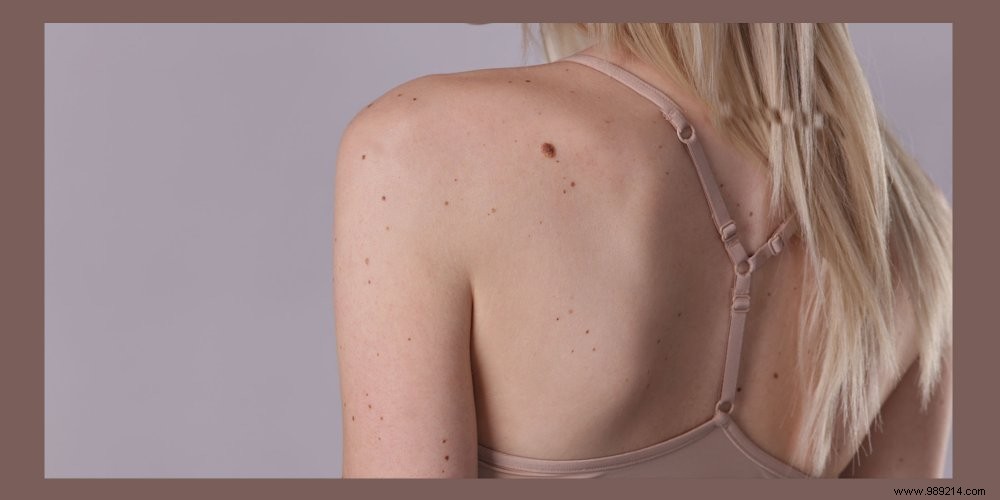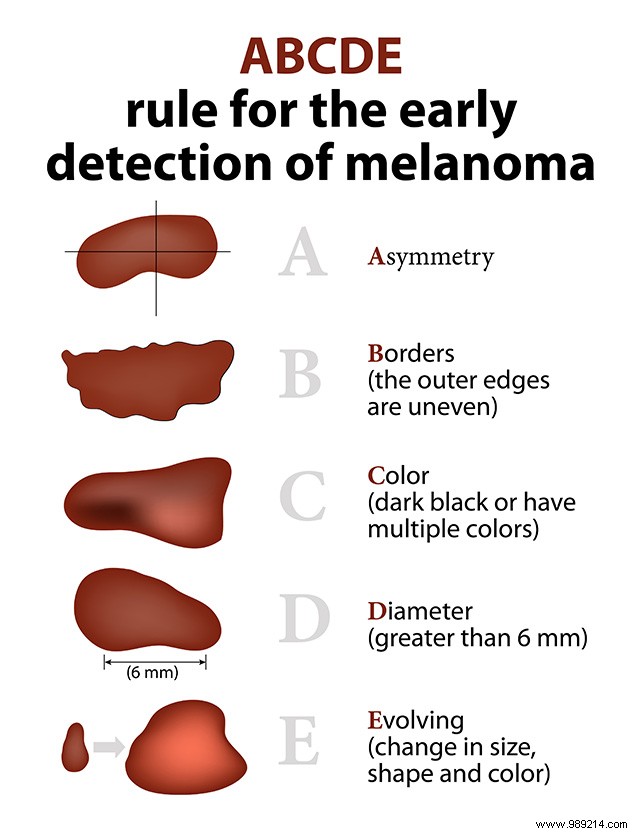 While most moles are harmless, some can be dangerous. How to check that they are not cancerous? Isabelle Gallay, dermatologist, gives us the procedure to follow to control them well.
While most moles are harmless, some can be dangerous. How to check that they are not cancerous? Isabelle Gallay, dermatologist, gives us the procedure to follow to control them well. Dermatologists regularly stress the importance of screening for melanoma, the most aggressive skin cancer, urging as many people as possible to protect their skin from the sun and have their moles checked regularly. The National Syndicate of Dermatologists-Venerologists recalls that most moles are harmless. However, it is necessary to monitor them to check that they do not evolve. Especially since melanoma spreads quickly.
As a reminder, melanoma is the leading cause of death for women aged 25 to 29 and 2/3 occur on healthy skin without a pre-existing mole.
Moles, also called "nevus" develop from childhood, with a peak in adolescence and until the age of about 30 years. In an adult, we find an average of twenty scattered all over the body. Their number nevertheless varies according to heredity but also according to sun exposure
Isabelle Gallay, dermatologist, advises everyone to have their moles checked regularly, at least to reassure themselves. Indeed, according to La Ligue contre le Cancer, 7,000 new cases of melanoma are diagnosed in France each year.
"Thanks to the National Syndicate of Dermatologists-Venerologists, anyone can make an appointment for a screening consultation once a year," she recalls.
 dnberty/iStock
dnberty/iStock
This consultation is particularly recommended for people who have a family history of skin cancer or atypical moles. And in case of doubt, the good reflex is always to consult your dermatologist.
Video of the day:The first thing to do is to get to know your skin. Isabelle Gallay advises taking a reference photo, on which we can compare our skin. It is necessary to observe yourself well and ask a third person to look at the more difficult areas, such as the back.
The Syndicate breaks down self-examination into eight steps:
Using a mirror, observe the neck, shoulders and back, then the buttocks and the back of the thighs. Finally, in a seated position, the front of the thighs, the legs, the back, the soles of the feet, without forgetting the nails and the genital area, using a mirror.
Thus, by observing yourself regularly, you quickly notice the appearance of a new spot that is different from the others or if a mole is changing rapidly.
There is also a free application, developed by the Institut Gustave Roussy, the leading cancer center in Europe, which allows you to monitor your moles:iSkin . We download it quickly, to set up a routine of self-examination of its moles.
To be reassured, a consultation at the slightest doubt is the safest reflex. However, if most moles - including new ones that may appear - are harmless, certain criteria should alert you. The Syndicate thus recalls the ABCDE rule, for self-examination. Each letter corresponds to a criterion.
A for asymmetry: if the mole has a non-circular shape with two dissimilar halves.
B for jagged edges: the borders are jagged, poorly defined and sometimes the pigments extend onto the skin around the stain.
C as inhomogeneous color: the mole has several colors, black, red, blue, brown or white.
D as diameter: if it is more than 6 millimeters or if it is increasing rapidly.
E for evolution: if it changes appearance too quickly.
 ©iStockphotos.com/ttsz
©iStockphotos.com/ttsz
Isabelle Gallay insists on this last point, evolution. This criterion alone should alert. When we notice the appearance of a new task or the evolution of a mole, we monitor it. If it changes, if it gets bigger, if it becomes rough in three months, you have to go for a consultation.
If in doubt, the dermatologist performs a biopsy to determine if the mole is cancerous or not. In 80% of cases, the melanoma is benign, an extraction is made in situ and healing is immediate.
If the suspicion is significant, "we may take a little more with a security perimeter of 5 mm", specifies Isabelle Gallay. What if you scratch a mole and it bleeds? In this case, do not panic, it is not necessarily dangerous. The prevailing rule is that of vigilance, observation of the evolution and knowledge of your skin. If in doubt, we consult a dermatologist, who will be able to reassure us or treat us.
Finally, Isabelle Gallay reminds us that it is essential to avoid exposure to the sun between 11 a.m. and 4 p.m. and to protect your skin from UV rays throughout the year with a cream. In summer, when the sun hits hard, protect your head with a hat or cap and regularly apply sunscreen with an index of 30 (at least).
Read also: